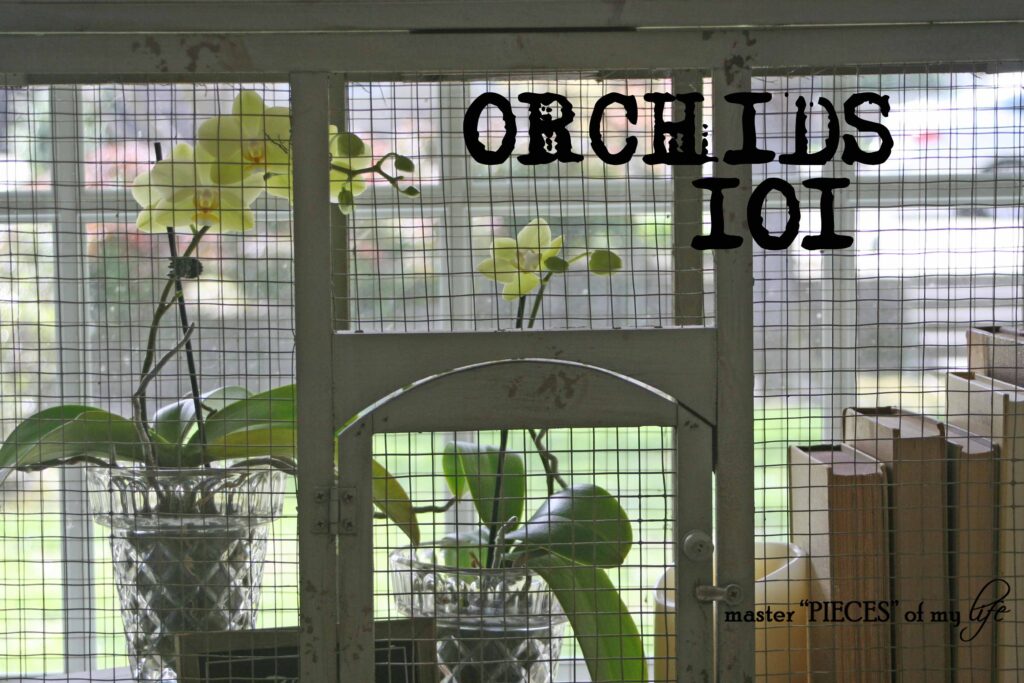Happy Daylights Savings Day! Although we lose an hour today, we will benefit from longer days and added daylight in our days going forward. Believe it or not and whether you realize it or not, having light raises our spirits and brightens our pet’s days. Plus it helps all our indoor fauna thrive as well. Today I plan on sharing everything I know about household orchids. Come on in and let’s talk orchids 101.
Let me preface this post by saying I am by no means an expert, but I do know enough to bring new blooms back to my orchids year after year. I have had these orchid plants for about 4 years now and I get repetitive, multiple blooms every Spring.
*Affiliate links might be included for your convenience. These affiliate links mean a small commission is earned if you make a purchase using these links at no extra cost to you. As an Amazon Associate qualifying purchases support this website. For more information: Full Disclosure Policy.
The Skinny on Orchids
I am guessing I know more about orchids than some but I certainly do not know more than many. Orchid varieties run far and wide and were traditionally perceived as an exotic plant, but some of that has been debunked nowadays with the normal appearance of the common Phalaenopsis in grocery stores, home improvement centers and local nurseries. These blooms are not particularly expensive and tend to be fairly easy to tend to.
My observations and recommendations here apply more to the Phalaenopsis and the like since there a gazillion different orchid species. Okay, I exaggerate a tad bit, since it’s more like 20,000 plus species and 100,000 plus hybrids, which is a lot and I am definitely NOT familiar with all of them. I simply speak here of your regular everyday orchids that we sometimes receive as a hostess gift, or plop in our powder room when we are receiving guests, or grab as an impulse buy during our daily errands because they call to us from their aristocratic status and delightful profiles.
I have some very basic information I am sharing here today because it has served me well. The variety that I have is in the Cymbidium family, which is also pretty common and I believe I purchased it at Trader Joes. I certainly got my bang for my buck with these plants and they have taught me plenty on how to take care of them along the way. Orchids are perennials so they should come back year after year. They are a pretty hardy plant but just because they stay alive, it does not mean they will produce flowers every year. They will basically just have leaves and roots, which although organic, not as pretty as a long stem full of multiple blooms.
I have some very basic information I am sharing here today because it has served me well. The variety that I have is in the Cymbidium family, which is also pretty common and I believe I purchased it at Trader Joes. I certainly got my bang for my buck with these plants and they have taught me plenty on how to take care of them along the way. Orchids are perennials so they should come back year after year. They are a pretty hardy plant but just because they stay alive, it does not mean they will produce flowers every year. They will basically just have leaves and roots, which although organic, not as pretty as a long stem full of multiple blooms.
Optimal Conditions for Orchids to Thrive
These common types of orchids live in soil with fibrous roots, rhizomes or tubers. This probably sounds pretty normal or basic but I’m differentiating from more exotic orchids that grow on trees or rocks. I have no experience with those personally but they are a masterpiece of nature. The orchid tips here are for indoor plants. The most critical factor for growing a thriving orchid indoors is natural light.
Light
When my orchids are showing off with their pretty blooms from about February to April | May, they hang out in this decorative bird cage in front of a very large window in the living room for all to enjoy. Once the blooms are all spent I trim the stem down and place the plants on a window ledge in the powder room. It has worked like a charm! I did this the first year I owned them as a last ditch effort to get them out of the way when I was restyling the birdcage. Unbeknownst to me it created somewhat of a greenhouse effect, which provided the plants with the perfect amount of light while they refueled. The window is frosted a bit so it’s a muted natural light. I do not recommend intense, direct sun rays shining on the plant because believe it or not it will become sunburnt. Having this natural light on them during most of the year while they are dormant has been key to getting those pretty blooms in the new year. Along with the natural light orchids also require some humidity to keep them at their happiest.
Humidity
Although in the wild most orchids grow in highly humid climates most house orchids are fine with moderate humidity. Bathrooms are probably the rooms in our house that generate the most humidity due to all the running water. So once again, moving them to the powder room was a great move whether I realized it at the time or not. Another trick is setting your orchid pots on a tray of gravel with water allowing for the water to evaporate around them. I also recommend misting them regularly as an extra measure. Along with the humidity the temperature also affects orchids (as most house plants).
Temperature
The common orchids we are discussing enjoy the same temperatures we do in our homes. I would say the average temperature for our home is around 70o. I would not recommend moving them to the garage or potting shed, etc. during the winter because this will not allow them to get strong enough and regenerate to push out a stem with blooms in the spring when you bring them inside. Although they are in a dormant stage during these winter months they are working hard inside to refuel and reenergize. Find somewhere in your home where you can tuck them away, but maintain acceptable living conditions, so they can be strong. Like any living thing water is also a necessity.
Water
There is not an exact science on water quantity and frequency for orchids or any house plant for that matter since it depends on the humidity & air quality of your home or container size and material, etc. There are a number of variables. I water all my house plants once per week and this seems to work pretty good. With orchids you just want to make sure the roots do not sit in stagnant water since they will develop root rot. I would suggest that when in doubt do not water since orchids have a water reserve in the roots & leaves.
Fertilizer
When I first started with orchids I purchased all orchid specific items like soil, food etc. Well somewhere along the way I just decided to use my regular houseplant fertilizer with my orchids and it does not seem to bother them one bit. I will admit, I do not know scientifically if this is the right thing to do but it has worked for me so far so I thought I would share that. There seems to be so many products on the market that are orchid specific but I do not use any of them. I fertilize | feed all my houseplants pretty much every time I water them by using a liquid fertilizer I add in the watering can when I fill it. I did read somewhere that they really require to be fed most during those dormant months and not so much when they are in full bloom, but it’s just easier for me to keep fertilizing them all year round since I use the same watering can to water all my indoor plants at the same time.
Closing Thought
Like any living thing you need to listen to them. Orchids will talk to you mostly through their leaves if they are not doing well and require help. Yellowing or spots on the leaves are clear indicators as well as all or most leaves dropping off. I became aware of all these factors after I noticed how well my orchids preformed. Based on some facts I already knew about orchids I made some diagnosis and other details I researched. If you have orchids in your home I hope this has helped you or maybe it will encourage you to invest in one. There are so many different varieties in size, color, shape, etc. that there really is something for everybody. Fun factoid: the only color orchids do not come in is black.
Where flowers bloom so does hope.”
Lady bird Johnson

